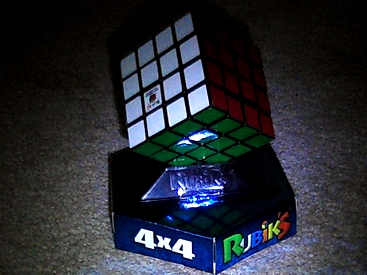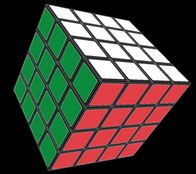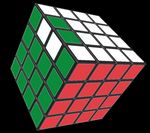4x4x4

Check out the NEW version of the site, less ugly and with videos!
Step 1: Getting the Centers
.jpg) Get all the 4 cube centers on each of the 6 sides of the cube to be the same color. Remember what your cube looks like before you mix it up, you have to get the centers in the correct spot or it wont work out later on. For a normal Rubik's Cube white is across from yellow, and if you hold white as your top and yellow as bottom, then these hold true: green is a cross from blue, red is across from orange, red is to the right of green, orange is to the left of green.
Get all the 4 cube centers on each of the 6 sides of the cube to be the same color. Remember what your cube looks like before you mix it up, you have to get the centers in the correct spot or it wont work out later on. For a normal Rubik's Cube white is across from yellow, and if you hold white as your top and yellow as bottom, then these hold true: green is a cross from blue, red is across from orange, red is to the right of green, orange is to the left of green.
|
OrientationChoose a side and decide what color it should be. Find that color on the other middles of the cube Algorithm(center1).jpg) .jpg) (center2).jpg) .jpg) (center3).jpg) .jpg) (center4).jpg) Basicaly what is happening is that you are putting the cubie you need in a position that you can move the bottom over, match up two, but them both on the bottom, then mobe the bottom back over. So essentially everything except those two sides were affected. |
Step 2: Aligning all edges
.jpg) Match up edges so that each of the edges matches up with another edges piece, to create one 2 piece edge piece that will stay together through the rest of the cube, its the last step in turning your 4x4 into a 3x3. Every edge you allign you want to store in the top and bottom (ex: White and Yellow sides, and solve for the edges in the red, green, blue, and orange sides).
Match up edges so that each of the edges matches up with another edges piece, to create one 2 piece edge piece that will stay together through the rest of the cube, its the last step in turning your 4x4 into a 3x3. Every edge you allign you want to store in the top and bottom (ex: White and Yellow sides, and solve for the edges in the red, green, blue, and orange sides).
|
(1).jpg)
.jpg)
(3).jpg)
OrientationMake white top, and find to of the same edge pieces, and lign them up like in the picture above and to the left. Algorithmallign the two edges up right next to each other, then turn the left or right sides in order to put the edges you ligned up on the top, the move the ligned up edge out of the way (turn the top clockwise or counterlockwise) and then pull the side back down, and fix the middles. Example(ex-1).jpg)
.jpg)
(ex-2).jpg)
.jpg)
(ex-3).jpg)
.jpg)
(ex-4).jpg)
.jpg)
(ex-5).jpg)
.jpg)
(ex-6).jpg)
Essentially you make a fixed side and in the proccess slightly mix up the centers, put it on top, then swap in an unsolved edge, then fix the centers |
|
(These next to algorithms are most commonly used when there are no more unsolved edges to swap) (1).jpg)
.jpg)
(2).jpg)
OrientationStart by designating a color as top, my choice is normaly white. Try and match up the single edge pieces like in the image above, do the algorithm, and then AlgorithmTurn the right side clockwise, the front counterclockwise, the top clockwise, right side back counterclockwise, and the front back clockwise. Shorthand:R-F'-U-R'-F--> |
(2).jpg)
.jpg)
(3).jpg)
OrientationLign it up so you have two of the same types of edges in the same row like in the image above and to the left. AlgorithmTurn the bottoms clockwise, the right side clockwise, the front counterclockwise, the top clockwise, right side back counterclockwise, the front back clockwise, and the bottom back counterclockwise. Shorthand:2(Dd)-R-F'-U-R'-F-2(Dd)'--> |
Step 3: Solve like a 3x3
.jpg) Here you want to get as far as you can as if you were solving this cube like a 3x3x3 cube. Make sure you dont mess up the middles, treate them as the middle on the 3x3x3, and treat the sides you lined up as edges on the 3x3x3. Solve as far as you can, at the very end you may run into a problem which can be corrected in the next step.
Here you want to get as far as you can as if you were solving this cube like a 3x3x3 cube. Make sure you dont mess up the middles, treate them as the middle on the 3x3x3, and treat the sides you lined up as edges on the 3x3x3. Solve as far as you can, at the very end you may run into a problem which can be corrected in the next step.
|
OrientationJust like you would a 3x3x3. AlgorithmMake sure you move the edges only, keep the centers and edges that you lined up in tact, and solve like you would a 3x3x3. |
Step 4: Fixing the Parities
 You will be merrily solving like a 3x3, when the cube seems unsolvable. You will have to fix these perities to finish the cube.
You will be merrily solving like a 3x3, when the cube seems unsolvable. You will have to fix these perities to finish the cube.
|
Orientationmake the cube so that you are holding like you are doing the last step of the 3x3, with the last side you are solving on the top. AlgorithmTurn the middle right 180 degrees, then turn the top 180 degrees, then turn the middle right 180 degrees again, and this time turn both tops 180 degrees, turn right side 180 degrees yet again, and the middle top, and you have swaped the 2 middle edges. Shorthand:2r-2U-2r-2(Uu)-2r-2u--> |

OrientationMake it so you are looking at the perities 0.o in the top front edge like in the picture above. AlgorithmTurn the middle right side 180 degrees, back 180 degrees, top 180 degrees, turn the middle left side clockwise, the top 180 degrees, middle right side counterclockwise 90 degrees, top 180 degrees, middle right side clockwise 90 degrees, top 180 degrees, the front 180 degrees, the middle right clockwise 90 degrees, the front 180 degrees, the middle left counterclockwise 90 degrees, then back 180 degrees, and finaly turn the middle right side 180 degrees. That wasnt so long now was it. Shorthand:2r-2B-2U-l-2U-ri-2U-r-2U-2F-r-2F-li-2B-2r--> |
Step 5: Finish like a 3x3
 Now you can finaly finish solving the cube, yay.
Now you can finaly finish solving the cube, yay.
|
OrientationJust like you would a 3x3x3. AlgorithmMake sure you move the edges only, keep the centers and edges that you lined up in tact, and solve like you would a 3x3x3. You should only have to end up doing edge swaps and corner rotations. |